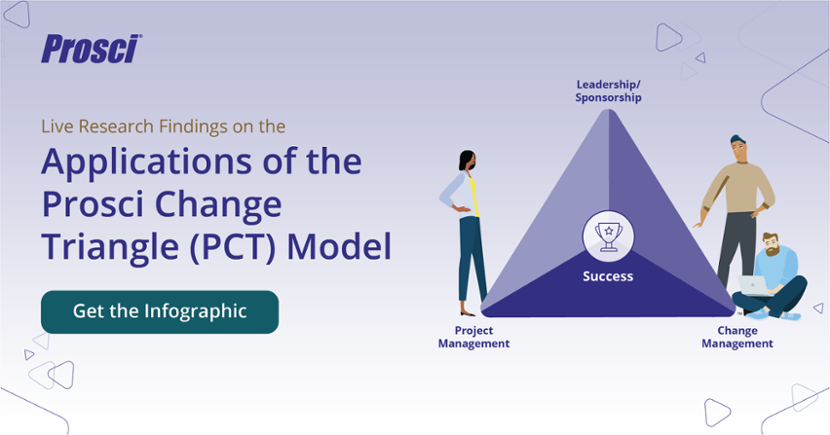You have no items in your shopping cart.
Research Shows 10 Ways Change Managers Use the PCT Assessment Today

4 Mins
Updated: August 2, 2024
Published: November 1, 2022

If you’ve ever wondered how to use the Prosci Change Triangle (PCT) Assessment more effectively, we’ve got some helpful research findings for you. Prosci asked experienced change practitioners to share their go-to applications of this flexible tool, so you can use them to enhance your practice.
The PCT Model and PCT Assessment
The Prosci Change Triangle (PCT) Model describes the four critical aspects of any successful change management effort, and how they interrelate. Strength across all aspects is critical for success. If one or more aspects of the model are not well supported, the entire project or initiative runs the risk of failure.
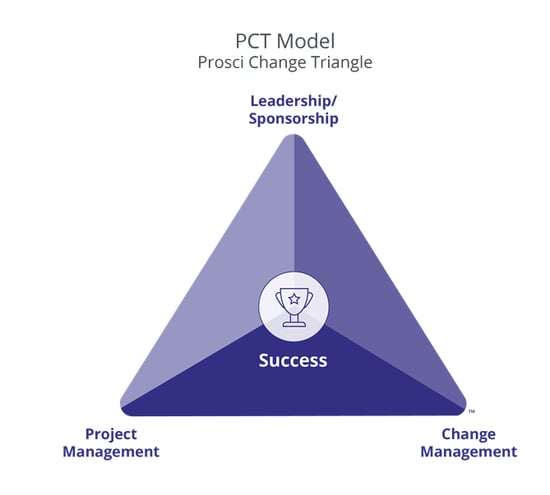
When you get certified in change management, you will learn how to apply the Prosci Methodology and tools, including the PCT Assessment. Completing the assessment of your change at the start of a project offers a holistic view of your change strategy and enables you to move forward with focus and intent.
Research Findings on
How to Apply the PCT Assessment
The PCT Assessment is the tool that makes your understanding of the PCT Model actionable, so you can improve the effectiveness of your changes. Here’s what experienced change practitioners told us during a live research study about how they use the tool to improve their change management practice:
1. Improve dialogue and communication
When we asked practitioners why they value the PCT Assessment, this was their top reason. The PCT Assessment is a helpful conversation starter with members of project teams, senior leaders and sponsors. It’s also easy to explain to people who do not work in change management.
2. Align stakeholders
The PCT Assessment is especially useful as a tool for aligning people across functions. As a concrete activity, it offers a hands-on, visual way to achieve a shared vision of success between leaders and practitioners, so they understand why and how they must work together during a change. It also serves as a resource to get project managers on board with the need to integrate project management and change management (the technical side and people side of change) to achieve a unified value proposition.
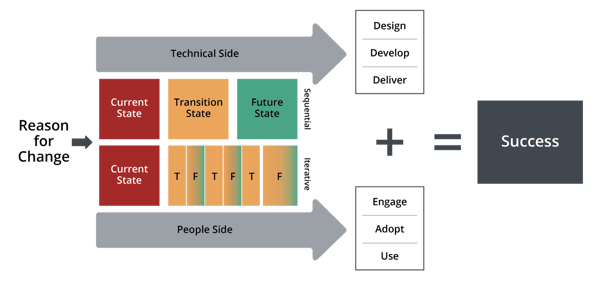 Unified Value Proposition
Unified Value Proposition
3. Support role integration
Once stakeholders understand why they need to execute their unique roles during change, the PCT Assessment helps you get them on the same page with what they need to execute. These are the conversations that help leadership and members of the change team understand who is expected to do what to contribute to a successful change. The result is like a well-choreographed dance. Leaders understand their part to lead the change actively and visibly. Project teams understand their responsibilities to design, develop and deliver the technical side of the solution. And change teams are clear on their roles of helping people engage, adopt and use the change.
4. Prioritize activities
When used as a framework and guidance for your change, the PCT Assessment offers you a way to focus your efforts and prioritize critical aspects of the change. Rather than simply asking what you should be doing, running the assessment various times throughout your project lifecycle makes it easy to differentiate which specific actions need your immediate focus from those that can wait. Additionally, the factors within each aspect are ordered in a logical, progressive sequence to guide next steps and priorities.
5. Facilitate collaboration
Our research shows that email is nine times less effective for conducting PCT Assessments than collaborative approaches. Instead of sending an email attachment, working through the assessment in person or in a virtual meeting is a great opportunity to connect with key roles in your organization and elicit deeper insights about your change together.
This is true whether you work as an internal change manager or an external consultant. Although internal change practitioners tend to facilitate shorter sessions than external consultants do, both groups find collaborative, facilitated sessions far more effective than conducting PCT Assessments alone. In fact, only 11% of practitioners in Prosci’s research study thought it was most effective to conduct PCT Assessments on their own. In other words, they're more likely to achieve better outcomes from doing the PCT Assessment with people rather than for them.

6. Measure and track performance
Using the PCT Assessment across the project lifecycle is a common practice among experienced change practitioners who want to check on performance of change management activities over time. The research reveals that practitioners commonly use the PCT Assessment to set a baseline at the beginning of the project, measure progress in the middle, then measure outcomes at the end.
7. Assess project health
In addition to understanding performance on change management activities, practitioners use the PCT as a diagnostic tool to understand the project’s overall health. In fact, 67% of study respondents apply the tool at least three times across the life of the project, and 51% apply it more often.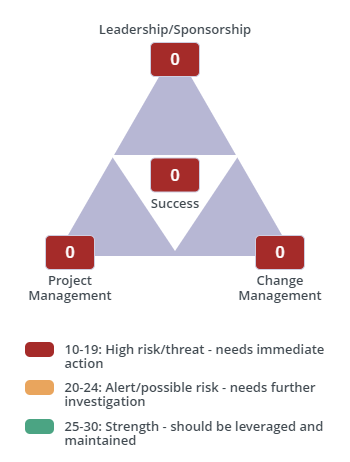
PCT Assessment
8. Identify project risks
The PCT Assessment tool uses color-coded scoring to show clearly which areas of the project are currently at risk. For example, a common situation for many change practitioners is to be brought into a project where the business case, charter, scope or plan has not yet been defined for the project. This factor would contribute to risk in the Success aspect of the assessment. Once the risk is identified, you can immediately act, working together with the project sponsors and project management team to address the risk by defining and clarifying those initial inputs to the change management process. So, when we start to use the assessment as a diagnostic tool, we see where we’re falling short and what risks are cropping up that we need to put focus, effort and energy toward.
9. Develop adaptive actions
Once we identify the risks to our change, we must choose the corrective actions. How do we know which actions to choose? What are the improved next steps I can formulate now that I’ve gathered new information? The PCT Model gives us the insights we need to develop adaptive actions, those “better” next steps in the areas that are presenting us risk.
10. Inform ECM efforts
Some organizations that are building change capability use the PCT Assessment to inform their enterprise change management (ECM) efforts. If we look at PCT assessment scores across a portfolio of changes, we can start to evaluate overall portfolio health. If in our evaluation we notice, for example, that most projects are struggling in the Project Management aspect, we might suggest a formal effort to improve project management across the enterprise. Once we identify systemic gaps in capabilities, we can also adjust and improve on the next change we're about to launch.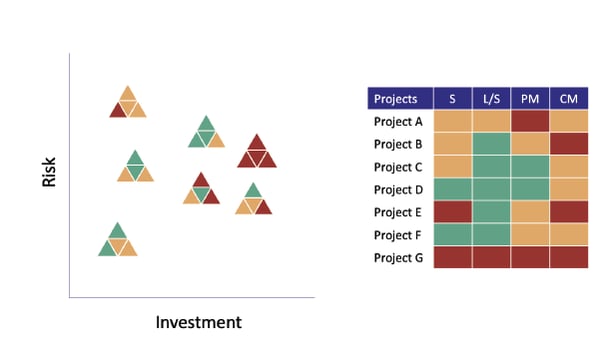
How Change Managers Use
the PCT Assessment
Prosci research reveals that PCT Assessment enables change practitioners in many ways—as a diagnostic tool, learning and guidance framework, collaborative approach for alignment and communications, and more. As a flexible and versatile tool, using it often over the lifecycle of your projects can enable better outcomes on projects and initiatives, as well as your efforts to build enterprise change capability in your organization.
